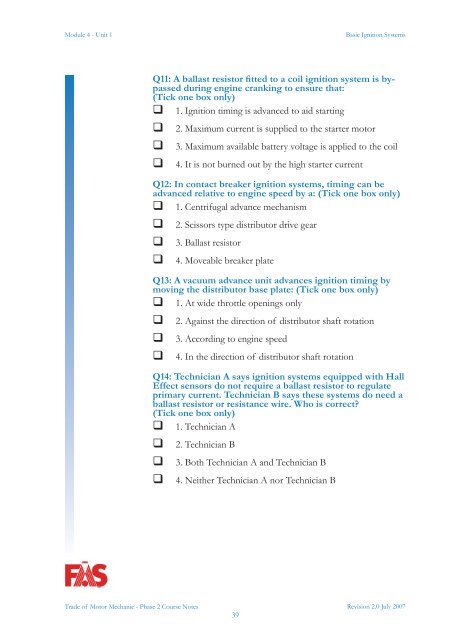Trade of Motor Mechanic - eCollege
Trade of Motor Mechanic - eCollege
Trade of Motor Mechanic - eCollege
You also want an ePaper? Increase the reach of your titles
YUMPU automatically turns print PDFs into web optimized ePapers that Google loves.
Module 4 - Unit 1 Basic Ignition Systems<br />
<strong>Trade</strong> <strong>of</strong> <strong>Motor</strong> <strong>Mechanic</strong> - Phase 2 Course Notes<br />
Q11: A ballast resistor fitted to a coil ignition system is bypassed<br />
during engine cranking to ensure that:<br />
(Tick one box only)<br />
1. Ignition timing is advanced to aid starting<br />
2. Maximum current is supplied to the starter motor<br />
. Maximum available battery voltage is applied to the coil<br />
4. It is not burned out by the high starter current<br />
Q12: In contact breaker ignition systems, timing can be<br />
advanced relative to engine speed by a: (Tick one box only)<br />
1. Centrifugal advance mechanism<br />
2. Scissors type distributor drive gear<br />
. Ballast resistor<br />
4. Moveable breaker plate<br />
Q13: A vacuum advance unit advances ignition timing by<br />
moving the distributor base plate: (Tick one box only)<br />
1. At wide throttle openings only<br />
2. Against the direction <strong>of</strong> distributor shaft rotation<br />
. According to engine speed<br />
4. In the direction <strong>of</strong> distributor shaft rotation<br />
Q14: Technician A says ignition systems equipped with Hall<br />
Effect sensors do not require a ballast resistor to regulate<br />
primary current. Technician B says these systems do need a<br />
ballast resistor or resistance wire. Who is correct?<br />
(Tick one box only)<br />
1. Technician A<br />
2. Technician B<br />
. Both Technician A and Technician B<br />
4. Neither Technician A nor Technician B<br />
9<br />
Revision 2.0 July 2007
















